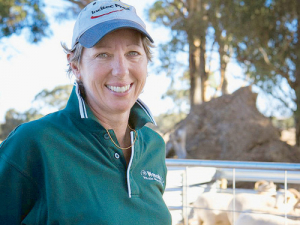Top wool advocate bales out
The conversion of productive farmland into trees has pretty much annihilated the wool industry.
 Australian livestock consultant San Jolly says maximising ewe survivability and profitability are underpinned by four key profit drivers.
Australian livestock consultant San Jolly says maximising ewe survivability and profitability are underpinned by four key profit drivers.
Managing ewes for maximum survival and profitability is underpinned by four key profit drivers, says Australian livestock consultant San Jolly.
Jolly, of Productive Nutrition, recently spoke about those profit drivers to producers at ‘Pastoral Profit’ workshops, held jointly by Meat and Livestock Australia and Australian Wool Innovation, in NSW and Queensland.
He reminded producers that measuring and monitoring are vital to guide management, and productivity improvements lead to profits only by reassessing cost of production annually and running gross margin budgets on feeding strategies.
Jolly says the first step to assessing the nutritional requirements of ewes is to weigh them, “to provide a baseline to monitor weight gain/loss for early intervention and management”.
Based on ewe weights and fertility (measured by pregnancy scanning), producers can determine their DSE (dry sheep equivalent) and estimate feed demand.
Jolly’s tips are: buy scales to monitor weight gain or loss for targeted management, assess readiness for joining, and ensure the dosage of drenches is correct for the weight of the sheep.
The second step concerns feed quality. “The best time to test feed quality is before you need it – before lambing and again before weaning”.
Feed test results can guide decisions on the cost-effectiveness of supplementary feeding if pasture protein levels are low, and provide information about whether pasture condition or other factors (such as genetics) are influencing weight gains.
Her tip is that feed quality cannot be accurately assessed visually; consultants can advise on how to take accurate samples and where to send them for laboratory testing.
The third step is stocking rates. There are several times of year and methods to assess stocking rates (based on kgDM/ha) including when there is a feed wedge before sheep go into a paddock, or during winter when pasture is growing.
Fourth is genetic potential. Genetics underpin the potential for fleece weight, fertility, growth rate and lamb survival.
Each enterprise will have different priorities so it is valuable to have formal breeding objectives to focus ram selection and culling decisions. Broad rules of thumb for optimising genetic profit drivers include:
Identify the constraints to your production system (such as environment or predation) and focus on areas within in your control.
Weigh lambs at weaning to see if genetics are translating to enhanced growth rates.
Match rams to your target market: for example, if producing store lambs then prioritise ASBVs for high weaning weights.
Joining presents another opportunity for producers to increase ewe productivity. With many pastoral producers preparing to wean now, Jolly says good pre-joining activities include:
Draft ewes into light/heavy or fat/thin mobs using the most efficient and appropriate method for your business (eID/auto drafting based on weight or condition scoring).
Start managing the light/thin ewes with preferential allocation of feed to bring them up to the target joining weight
Draft out dry ewes so they do not re-enter the breeding programme.
Now is the time to start planning for weaning nutrition by taking feed quality tests and mineral deficiency tests to guide supplementation decisions, says Jolly.
Additional tariffs introduced by the Chinese Government last month on beef imports should favour New Zealand farmers and exporters.
Primary sector leaders have praised the government and its officials for putting the Indian free trade deal together in just nine months.
Primary sector leaders have welcomed the announcement of a Free Trade Agreement (FTA) between India and New Zealand.
Dairy farmers are still in a good place despite volatile global milk prices.
Legal controls on the movement of fruits and vegetables are now in place in Auckland’s Mt Roskill suburb, says Biosecurity New Zealand Commissioner North Mike Inglis.
Arable growers worried that some weeds in their crops may have developed herbicide resistance can now get the suspected plants tested for free.